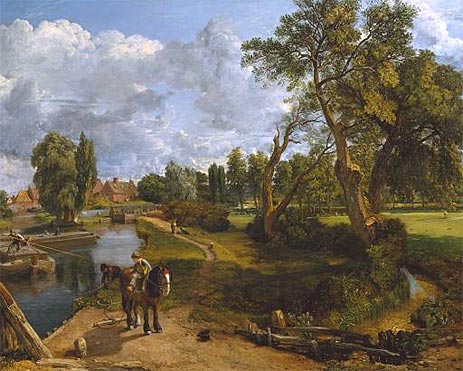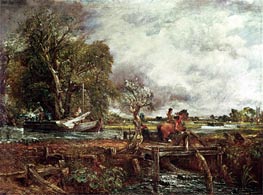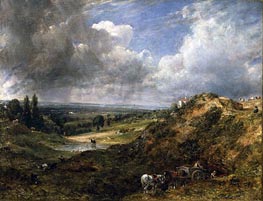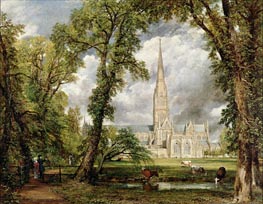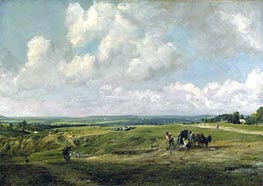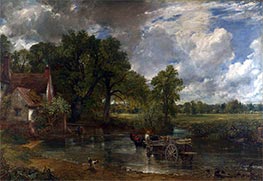Flatford Mill (Scene on a Navigable River), c.1816/17 by John Constable
Canvas Print - 2898-COJ
Location: Tate Gallery, London, UKOriginal Size: 101.6 x 127 cm
Giclée Canvas Print | $66.24 USD
Your Selection
Customize Your Print
By using the red up or down arrows, you have the option to proportionally increase or decrease the printed area in inches as per your preference.
*Max printing size: 23.9 x 29.9 in
*Max framing size: Long side up to 28"
"Flatford Mill (Scene on a Navigable River)" will be custom-printed for your order using the latest giclée printing technology. This technique ensures that the Canvas Print captures an exceptional level of detail, showcasing vibrant and vivid colors with remarkable clarity.
Our use of the finest quality, fine-textured canvas lends art reproductions a painting-like appearance. Combined with a satin-gloss coating, it delivers exceptional print outcomes, showcasing vivid colors, intricate details, deep blacks, and impeccable contrasts. The canvas structure is also highly compatible with canvas stretching frames, further enhancing its versatility.
To ensure proper stretching of the artwork on the stretcher-bar, we add additional blank borders around the printed area on all sides.
Our printing process utilizes cutting-edge technology and employs the Giclée printmaking method, ensuring exceptional quality. The colors undergo independent verification, guaranteeing a lifespan of over 100 years.
Please note that there are postal restrictions limiting the size of framed prints to a maximum of 28 inches along the longest side of the painting. If you desire a larger art print, we recommend utilizing the services of your local framing studio.
*It is important to mention that the framing option is unavailable for certain paintings, such as those with oval or round shapes.
If you select a frameless art print of "Flatford Mill (Scene on a Navigable River)" by Constable, it will be prepared for shipment within 48 hours. However, if you prefer a framed artwork, the printing and framing process will typically require approximately 7-8 days before it is ready to be shipped.
We provide complimentary delivery for up to two unframed (rolled-up) art prints in a single order. Our standard delivery is free and typically takes 10-14 working days to arrive.
For faster shipping, we also offer express DHL shipping, which usually takes 2-4 working days. The cost of express shipping is determined by the weight and volume of the shipment, as well as the delivery destination.
Once you have added the paintings to your shopping cart, you can use the "Shipping estimates" tool to obtain information about available transport services and their respective prices.
All unframed art prints are delivered rolled up in secure postal tubes, ensuring their protection during transportation. Framed art prints, on the other hand, are shipped in cardboard packaging with additional corner protectors for added safety.
Painting Information
The painting emerged at a moment when the artist, on the verge of marriage, sought to produce larger canvases directly from nature - a practice that had rarely been seen on this scale. The summer of 1816 found him at East Bergholt, determined to capture the Suffolk scenes of his youth. These riverbanks and milling operations, so intimately tied to his family's business, had already made him a painter in his own words. Yet this work also represents a transitional phase: after first exhibiting it in 1817, he returned to the studio and revised the treetops and sky, revealing a method that combined spontaneity with meticulous rethinking.
One's eye is guided through a series of subtle diagonals, from the cluster of timber in the immediate foreground toward the tow-horse and the pair of boys engaged in their daily labor. The waterway then draws attention to the cluster of buildings, suggesting the quiet hum of commerce behind the rustic setting. Such compositional lines unify the bustling river scene with the tree-lined fields, balancing human industry with the vastness of nature. The inscription scratched into the earth in the foreground provides a discreet but eloquent sign of the artist’s personal mark on a landscape he knew intimately.
The painting’s understated color palette brings a measured harmony between gentle browns, greens, and the expansive English sky that hovers in varying shades of gray-blue. The effect is neither overly dramatic nor muted; instead, it conveys the shifting temper of country weather. Such balanced hues reflect a desire to portray nature’s mercurial character without resorting to theatrical contrast. The brushwork underscores this same balance: one finds fresh, lively strokes in the foliage - a testament to painting en plein air on a large scale - while more precise details, such as the horse’s harness and the timber along the bank, were refined in the studio.
Looking at the scene itself, the viewer is drawn into a tangible world of rural labor: the barge must pass under the nearby bridge, so the rope is carefully removed. A second youth sits astride a tow-horse, prepared to resume the steady journey along the Stour. It is a work that quietly mingles documentary realism with personal memory, an homage to the artist’s boyhood domain. In exploring this location with canvas and brush, he left a chronicle of a working river, captured at once on site and in recollection, melding the practical rhythms of life with an intimate tribute to place.
